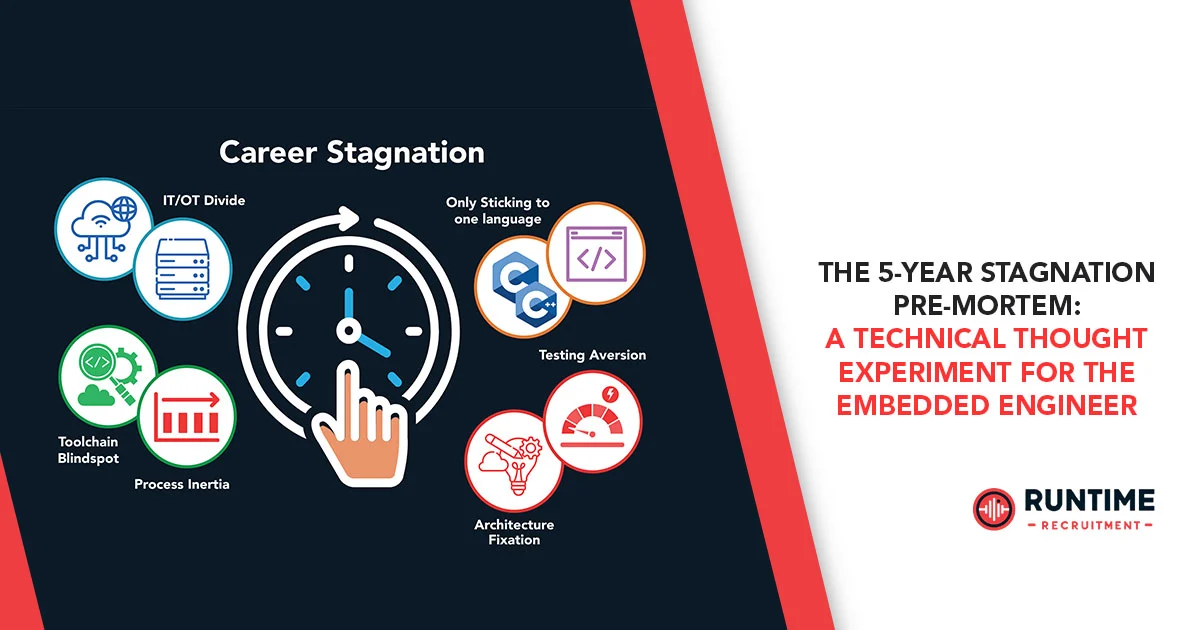Embedded engineering is a relentless, high-stakes discipline. The core skills that make you invaluable today—deep familiarity with a specific architecture, mastery of low-level peripherals, and a wizard’s touch with C—can, paradoxically, become the chains that lead to your career stagnation tomorrow. Unlike application development, where a new framework might launch every year, failure to evolve in the embedded space means the very silicon you master today will be retired tomorrow, leaving your expertise stranded on a defunct platform.
We all know the Post-Mortem: the painful, forensic analysis of a project failure that identifies root causes after the fact. We’re wired for it. We review logs, trace back commits, and pinpoint the exact line of code or design decision that caused the bug or the delay.
This article proposes the Pre-Mortem.
Imagine it is exactly five years from today. Your career is officially stalled. You haven’t received a meaningful raise or promotion. Your skills are deemed “niche” or “legacy,” making external job searches fruitless. You’re still solving the same class of problems you were five years ago, while your peers are leading teams working on bleeding-edge edge AI, secure IoT, or next-generation robotics.
Now, look backward. What specific, avoidable technical and professional decisions—or, more accurately, non-decisions—led to this failure? This structured thought exercise is designed to isolate and mitigate the specific failure modes unique to the embedded systems professional.
1. Failure Mode #1: The Silicon Silo (Technical Obsolescence)
In five years, you failed because you became the undisputed, yet tragically obsolete, expert on an ancient stack. You stuck with the architecture you mastered in college or your first job, and your deep comfort became your deepest liability.
The Traps You Fell Into:
- The Architecture Fixation: You remained deeply nested in a single vendor’s ecosystem—perhaps a proprietary 8-bit MCU family or a specific, legacy Digital Signal Processor (DSP). You resisted the industry’s tectonic shift toward platform-agnostic design and failed to bridge your low-level understanding to modern, high-demand platforms like RISC-V or the latest ARM Cortex-M/R series with advanced security features. You can recite the register map of your favorite chip from memory, but you can’t confidently discuss the advantages of a multi-core heterogeneous architecture.
- The Toolchain Blind Spot: Your debugging methodology hasn’t changed since 2010. You still rely primarily on strategically placed printf statements, ignoring the power and efficiency of advanced tools. You never bothered to master advanced techniques like J-Link/ST-Link scripting, custom GDB automation, complex event analysis on a logic analyzer, or high-speed protocol sniffers for modern interfaces like PCIe or high-speed Ethernet. You debug for hours what a simple tool could show in minutes, making your time expensive and your impact low.
- Neglecting the RTOS Evolution: You stuck to your company’s decades-old, in-house Real-Time Operating System (RTOS) or an unsupported, older version of a commercial kernel. You missed the critical industry transition to modern, secure, and actively maintained RTOS platforms like Zephyr or the Long-Term Support (LTS) versions of FreeRTOS. Consequently, you are unprepared to handle modern challenges like memory protection, secure firmware signing, and multi-protocol networking stacks.
The Pre-Mortem Mitigation Strategy:
Stop being the expert in a dying field. Dedicate 20% of your professional development time to an architecture you do not currently use, treating it as an open-ended project. Buy a development board for a competitor chip, flash a new-era RTOS, and write a driver for an external peripheral you’ve never touched before.
- Metric of Success (5 Years Out): You can confidently lead a discussion comparing the memory protection schemes of a Cortex-M MPU versus a full VMM system on a Cortex-A, and you have committed code to an open-source RTOS project.
2. Failure Mode #2: The Cloud Chasm (The IT/OT Divide)
In five years, your career stalled because you held a purist’s belief that the embedded engineer’s job ends at the last byte transmitted over the UART or the SPI bus. You treated your device as an island, ignoring the reality that every modern embedded system is an IoT endpoint.
The Traps You Fell Into:
- Security Inertia: You assumed security meant simply fixing buffer overflows in your C code. You never moved beyond code-level bug hunting to mastering system security. You ignored the fundamental necessity of a Hardware Root of Trust (HRoT), secure bootloaders, secure key provisioning, and leveraging architectural features like TrustZone or dedicated cryptographic accelerators. You released products that were easily compromised, making you a financial liability.
- The Network Ignorance: You remained comfortable with simple TCP/IP or proprietary protocols. You failed to gain fluency in the application-layer protocols that enable the Internet of Things: MQTT, CoAP, and gRPC for data exchange. You didn’t bother to truly understand the performance and memory constraints of implementing TLS/DTLS securely on a resource-constrained microcontroller. Your devices talked, but they didn’t speak the modern language of the cloud.
- The Data/API Aversion: You never cared what happened to the data your device generated. You saw the firmware as a black box and ignored the cloud backend. You failed to grasp the basics of REST APIs, JSON/Protobuf serialization, or the implementation challenges of Edge Compute models (TinyML). When your team needed you to optimize the data payload for a specific cloud service, you punted, demonstrating a profound lack of systems thinking.
The Pre-Mortem Mitigation Strategy:
Build a complete end-to-end project on your own time. Device → Cloud → Visualization. The focus isn’t the cloud; it’s the interface. Spend 70% of the project time ensuring a secure TLS handshake is established, and a reliable, authenticated OTA (Over-The-Air) update mechanism is implemented.
- Metric of Success (5 Years Out): You can architect and defend a complete security model for a new IoT product, from silicon provisioning to cloud revocation, and you are comfortable integrating AI inference models compiled for your target hardware.
3. Failure Mode #3: The Code Comfort Zone (The Quality Cliff)
In five years, you stalled because you remained an artisan in a field rapidly adopting industrial automation. You took pride in your ability to make messy C code “just work,” assuming that rigorous quality assurance was the job of high-level application developers.
The Traps You Fell Into:
- The C/C++ Only Mindset: You dismissed the growing movement toward memory-safe languages in firmware. You failed to seriously evaluate Rust and its utility for building robust drivers and application layers, particularly in safety-critical areas. Furthermore, you limited yourself by not mastering languages like Python for sophisticated build scripting, automated hardware testing, and device emulation/simulation. You remained a single-language specialist in a multi-language world.
- Testing Aversion and HIL Neglect: You treated Unit Testing as an academic exercise, failing to invest time in mastering frameworks that are actually practical for embedded systems (e.g., GoogleTest for embedded, Mocking frameworks). You never progressed to mastering Hardware-in-the-Loop (HIL) simulation, relying instead on manually plugging in devices and observing LEDs. Your test coverage remained near zero, making every code change a high-risk gamble.
- The Process Plateau: You continued to rely on manual, ad-hoc processes. You resisted adopting modern, structured development methodologies. You never championed the integration of a full CI/CD pipeline for your firmware, believing that Git commits and a nightly compile were sufficient. You failed to master and integrate industry-standard static analysis tools for compliance checks (e.g., MISRA, CERT-C), allowing your code quality to decay silently.
The Pre-Mortem Mitigation Strategy:
Treat process and quality as a project. Every quarter, introduce one new, measurable quality tool or process. Q1: Integrate a static analyzer and commit to fixing all high-severity warnings. Q2: Implement a full CI/CD pipeline (Jenkins, GitLab CI, etc.) for a small sample project that builds and flashes an emulator. Q3: Write an integration test using Python that exercises a crucial peripheral via JTAG/SWD.
- Metric of Success (5 Years Out): Your team’s code coverage is transparently tracked, and you have authored tools that automate testing on the hardware, cutting regression time from days to hours.
4. Failure Mode #4: The Non-Technical Decay (Communication and Leadership)
In five years, you became a highly skilled individual contributor (IC) hitting a ceiling because you couldn’t effectively connect your technical brilliance to business value. You were technically indispensable, but professionally inert.
The Traps You Fell Into:
- The Translation Barrier: You could only speak in the language of registers, clock speeds, and interrupt vectors. When management asked for a project update, you gave them an incoherent technical deep dive. You failed to develop the crucial skill of translating a complex technical risk (e.g., “The silicon vendor is dropping support for this driver architecture”) into a concrete business impact (e.g., “This requires a three-month delay in our next product launch and a $20,000 increase in license fees”).
- The Documentation Debt: You wrote poor, fragmented documentation, if any at all. This made you the Single Point of Failure (SPOF). You were too busy answering basic questions from new hires or other teams to be promoted to a strategic role. Your expertise was trapped inside your head, preventing the scaling of the entire organization.
- Project Management Paralysis: You saw scheduling and vendor relations as “someone else’s problem.” You failed to understand the impact of your code decisions on product cost, material procurement, and time-to-market. When the global chip shortage hit, you didn’t contribute to component end-of-life planning or secondary source qualification, proving you were a coder, not a systems leader.
The Pre-Mortem Mitigation Strategy:
Practice outward communication. Voluntarily write two concise, high-level summaries per month: one for management, explaining a technical risk in financial/schedule terms, and one for a non-technical stakeholder, explaining the embedded device’s value proposition in the simplest possible language. Commit to mentoring. If you can’t teach it, you can’t lead it.
- Metric of Success (5 Years Out): You are viewed as the strategic bridge between the hardware team, the software team, and the product management team, and you have mentored at least three junior engineers who are now competent ICs.
Conclusion: Turning the Pre-Mortem into a Post-Success
Stagnation in the embedded field isn’t a dramatic collapse; it’s the slow, cumulative result of failing to make small, consistent technical and professional investments. The five-year stagnant future we envisioned is merely a hypothetical failure case. Your five-year success is the concrete project plan you start debugging today.
Stop waiting for your company to provide the training or the project. Your career is your most complex, time-critical embedded system—and you are the only one with root access.
Call to Action:
Is your next career step already a priority? Don’t wait for the pre-mortem to become reality. Connect with RunTime Recruitment today to ensure your next role aligns with the future of embedded engineering.









